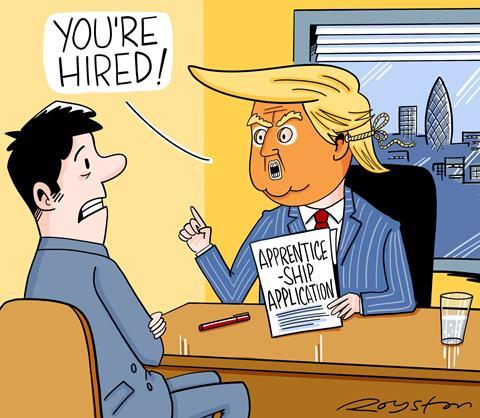Apprentices can breathe new life into law firms, hears Grania Langdon-Down, but the recruitment process requires a detailed business plan.
The introduction of the new Trailblazer apprenticeship route to qualification as a solicitor has the potential to be among the most significant changes to entry to the profession for generations.
Add in the only government funding for any education or training over 18 and a new apprenticeship levy system based on a ‘use it or lose it’ model, and it may be tempting for firms or in-house teams to think they must rush to jump on the bandwagon.
However, deciding to take on an 18-year-old school-leaver with no office experience or legal knowledge and plotting how they will fit into the business as a solicitor six years down the line requires a very detailed business plan.
While firms have taken on legal and business services apprentices for several years, the new lawyer apprenticeships which meet the employer-led Trailblazer standards bring significant changes in structure, delivery and funding.
The challenges have prompted the Law Society to produce guidance on funding, including the new apprenticeship levy, which will apply to apprenticeships that start after 1 May.
The Society has also published a booklet, The Apprenticeship Route into Law, as well as an apprenticeships webpage signposting resources.
Real value
The Society is also hosting events in Bristol on 9 February, followed by Manchester, Birmingham and Cardiff, to mark National Apprenticeship Week (6-10 March). These events will cover everything employers need to know about recruiting, training and supporting an apprentice.
‘Apprentices can breathe new life into a firm,’ says Jess Barwick, executive support officer at the Society. ‘They bring enthusiasm, new ways of thinking, and can offer skills that some firms may be lacking. Firms have told me they see real value in the way apprentices approach technology and the way they can apply technology to legal work.’
There is certainly plenty of enthusiasm from a broad range of firms and in-house teams. The first batch of Trailblazer apprentices, who are doing a mixture of two-year paralegal, four-year legal executive or six-year solicitor apprenticeships, started last September, with many firms recruiting again for this coming September.
In Wales, where skills policy is a devolved issue, the first solicitor apprenticeships were launched last September.
So where should you start? The first message is: don’t view this as just a corporate social responsibility box-ticking exercise. There needs to be a strong business case which has the backing of staff, because there are both direct costs – primarily salaries and in-house training – and indirect costs.
These include: developing interviewing and recruitment strategies to take on school-leavers; working with training providers; dealing with complicated funding arrangements; and ensuring robust standards and support are in place.
But plotting an apprentice’s potential progress over two, four or six years can be an opportunity to look forensically at your future workforce needs because there must be a genuine job available on completion.
Bond Dickinson was recently named winner of the Rolls-Royce Award for Newcomer Large Employer of the Year at the National Apprenticeship Awards.
It currently has seven legal apprentices, with four working in the firm’s support services teams, and is in the process of recruiting two solicitor apprentices for its Newcastle office.
Head of recruitment Samantha Lee says there is ‘huge appetite’ in the business for apprentices to provide a ‘pipeline’ of paralegals. But, she adds, what is important is to balance any requests carefully to ensure that the funding is available, given it accrues on a monthly basis.
When considering the business case for the new solicitor-apprentices, Lee says it is important to look at salary costs alongside sponsorship for postgraduate legal education and potential revenue generated by both apprenticeships and trainee solicitors.
‘You also need to factor in some of the time costs as there is no doubt that an apprenticeship requires more management time – but the rewards are significant.’
Taking on a school-leaver who will spend a day a week on study release is a very different prospect to a trainee. ‘But that’s not necessarily a bad thing,’ she notes. ‘Making the decision that this is the career for them at such a young age shows great drive and motivation, which is exactly what we’re looking for.’
The firm runs a placement scheme to give candidates an insight into the business before any formal interview. ‘That’s important for both sides,’ Lee stresses. ‘For our apprentices, it’s often the first time they’ve set foot inside a law firm so they need to know that they’ve chosen the right firm. For us, it allows us to see what they’re made of, and we haven’t been disappointed yet.’
Case study – a firm’s perspective
Kennedys’ HR team recruits apprentices from across England through an online application, video interview and assessment day, before a meeting with the team they are likely to be placed with.
The 10-week process is designed to assess how applicants cope with pressure, interact in a group and manage interviews.
Human resources adviser Nicola Standley explains in the Society’s The Apprenticeship Route into Law booklet that they are still battling the perception of schools and parents that apprenticeships aren’t as good as going to university. Six of Kennedys’ current apprentices are transitioning to solicitor apprenticeships and will be completing a law degree as part of the programme.
There are practical issues to consider first, she says: ‘Make sure the apprentices are placed with teams that really back the apprenticeships and have a dedicated supervisor. We give supervisors some training on what the apprentice will know, what they won’t know and what to expect from them.’
Horwich Farrelly launched the UK’s first legal apprenticeships in 2013 with a cohort of four, based at the firm’s Manchester head office. Over the last four years, it has offered 45 apprenticeships.
From September, its new apprentices will be offered the opportunity to do the Trailblazer paralegal apprenticeship, which introduces some additional competence sections and end-point assessments. Successful completion translates into credits towards a law degree.
However, Rita McGucken, the firm’s director of learning and development, says the firm does not currently have plans to introduce the solicitor apprenticeships, though they are monitoring this.
‘We can certainly see the attraction of the scheme to those leaving college as they will be able to qualify without the burden of student debt,’ she notes. ‘However, from a business perspective, it’s very difficult to predict our needs that far ahead. In addition, we feel asking an 18-year-old to commit to a six-year apprenticeship is a big commitment and it won’t be suitable for all.’
Complicated funding

Funding for apprenticeships is extremely complicated. Firms will need to estimate all the likely costs, given that government and levy funding can only be spent on training, education and assessment, including the qualification assessment. It cannot be used for wages or incidental costs, such as travel.
The Society’s research unit expects about 225 law firms to be caught by the apprenticeship levy, which applies to all employers with an annual pay bill of more than £3m, and puts the total cost to the firms at an estimated £13.7m.
The Society’s funding guidance points out that, although those employers will need to contribute 0.5% of their total pay bill to the apprenticeship levy, the government has also introduced a ‘levy allowance’ of £15,000 per year. This means that the total amount a levy-paying employer needs to spend is 0.5% of their pay bill, minus £15,000.
The government will apply a further 10% top-up to the funds, so for every £1 that enters the employer’s account to spend in England on apprenticeship training, they get £1.10.
A factual guide outlining the funding process in Wales is due to be published shortly.
Government guidance on apprenticeship funding says all levy-paying firms will be asked to register for their account this month.
If there is not enough in the account in a particular month because the employer only pays a small amount of levy, it will be asked to make a 10% contribution to the extra cost of training and pay this directly to the provider.
Those that do not pay the levy will not need to use the apprenticeship service to pay for apprenticeship training and assessment until at least 2018.
In the meantime, those employers will be asked to make a 10% contribution to the cost of the training, with the government paying the rest (90%), up to the maximum amount of government funding available for that apprenticeship. Employers will pay this directly to the provider, spread over the lifetime of the apprenticeship.
Added incentives include an extra £1,000 for any firm taking on an 18-year-old while the government will pay 100% of apprentices’ training, up to the capped amount, if an employer has fewer than 50 staff.
So – a non-levy paying employer may agree to pay their training provider £10,400 for training their paralegal apprentice. The upper limit of the paralegal funding band is £9,000, so the government will pay £8,100. The employer pays 10% (£900) plus the extra £1,400 for the agreed costs over the £9,000. A balance of 20% will be held back to be paid on completion of the final assessment.
The solicitor apprenticeship does not require a law degree but most providers are planning to offer it as part of their programme. Jason O’Malley, director of apprenticeships and new business at the University of Law, says the £21,000 funding cap for solicitor apprentices was reduced from £27,000, ‘which poses a challenge and is likely to lead to employers having to top up funds’.
Things you need to do
Plan – determine how many apprentices you want to take on, and at what level; estimate government funding and if you have sufficient resources to support them; select and train supervisors, line-managers and mentors
Register – register your interest with the National Apprenticeship Service
Select – a training provider
Fund – check eligibility for funding and if you are a levy-paying employer, register for an employer account
Recruit – you can do this yourself, which can be alongside the university recruitment round to target school-leavers. Or your training provider can help
Start – take on your apprentice, draw up the apprenticeship agreement and sign an apprentice contract with your training provider
Source: The Apprenticeship Route into Law, Law Society
What is important to remember, says Tim Woodward, a partner at Bond Dickinson, is that the funds in a firm’s apprenticeship account will expire after 24 months. ‘It is a “use it or lose it” model,’ he says. ‘The government’s guidance doesn’t say what happens to the funds once they expire – there is no suggestion of a refund to employers who pay the levy.’
From 2018, employers will be able to transfer up to 10% of their levy fund to another employer to support its apprenticeships, if they can demonstrate that it falls within part of their supply chain.
‘I think the way this will work,’ he says, ‘is that where a law firm has a supplier of facilities services, or, office equipment, or even catering, it may consider devoting some of its apprenticeship account to that supplier if there is a good business case for an apprentice who would be working with the law firm.
‘That way, there is a benefit to the law firm, indirectly, as well as other positive aspects such as helping another employer take on an apprentice while also ensuring funds in the account aren’t lost.’
McGucken is concerned that firms without an established apprentice scheme may be tempted to rush the launch of an initiative to make use of the funding.
‘We firmly believe recruitment has to be based on the needs of the business,’ she says, ‘so that apprentices gain sufficient experience and are not simply given menial tasks like photocopying, running errands and making tea.’
On the plus side, she says the new levy removes previous age restrictions which should encourage firms to extend their schemes to a wider age range, as well as existing staff.
Lifting the age restrictions also opens up the possibility of a ‘graduate entry’ apprenticeship for someone with a law degree or a non-law degree and the Graduate Diploma in Law.
Tricia Chatterton, director of BPP University Law School’s legal apprenticeship programme, says firms which have not previously sponsored a student on the legal practice course may consider a ‘graduate entry’ solicitor apprenticeship, given the funding for training. There would be no LPC as the training would be wrapped into the programme for the apprentice who could qualify in two and a half years.
For those deciding to go down the apprenticeship route, a key step is choosing their government-approved training provider.
Lowri Morgan, head of the Law Society’s Wales office, says one essential difference between England and Wales is that those employers who are subject to the levy in England will need to select training providers themselves and agree a price for the training. In Wales, the Welsh government will directly fund providers to work with employers to diagnose their needs and agree a training package.
Clear channels of communication are essential in developing a solid relationship with your training provider, McGucken says. She works with Manchester Metropolitan University and says the university ‘took time to understand our culture, our services and how our business operates. As a result of this symbiotic relationship, the university’s apprenticeship unit understands the type of applicant we’re looking for and has helped with our recruitment’.
Manchester Met will be offering the Trailblazer paralegal and solicitor apprenticeships from September. Director of apprenticeships Liz Gorb says: ‘Providers can advise on many aspects, such as funding and integrating the workplace and academic elements of the course, as well as providing a full support package pre- and post-appointment.’
City Law School started its programme for solicitor apprentices last September, including one employed by ITV, the first in-house solicitor apprentice in the country. It is currently working in partnership with CILEx Law School and the North East Solicitor Apprenticeship Consortium, formed by several law firms wanting to recruit solicitor apprentices in the area.
Liaise directly
The law school’s solicitor apprenticeship programme director Angela Jackman advises firms considering taking on a school-leaver solicitor apprentice to start thinking about the recruitment process as soon as possible.
‘Many students already have university offers and will be engrossed in preparing for A-levels,’ she says. ‘In my experience, the best route for firms is to liaise directly with schools and colleges so the opportunities are widely shared with young people and their parents.’
The University of Law offers a range of apprenticeships in partnership with Damar Training. It recently announced partnerships with Freshfields and Hogan Lovells for paralegal apprenticeships and with Fletchers Solicitors for the solicitor apprenticeship scheme.
For those who doubt whether apprenticeships will work for them, O’Malley says: ‘Apprentices usually sell themselves once a programme is established and any firm which has gone down this route over the past seven years will tell you that they can be a great influence in the workplace.’
More than 70 paralegal and solicitor apprentices started with BPP University Law School last September from a broad range of firms. These included Eversheds, Berwin Leighton Paisner, Kennedys, DWF, Burges Salmon, Blacks and Schofield Sweeney, and ranged from in-house legal teams to smaller niche and high street practices.
Chatterton says BPP works with clients to help define the job description and job role analysis so the firms can plan how and when their apprentice(s) will be able to meet the outcomes of the programme.
‘Firms also need to consider who will supervise the apprentice,’ she says. ‘This is an excellent development opportunity for associates looking to develop their people development and leadership skills, so apprenticeships can benefit the employer’s people strategy in multiple ways.’
What remains unclear both in terms of content and cost is the required ‘end point assessment’ in order to qualify.
The Solicitors Regulation Authority has been involved in the development of the Trailblazer scheme in England and the Welsh government-licensed Skills for Justice framework. But, as the schemes are regulated by the government, the authority’s focus is on standards through a two-part SRA-set exam.
It hopes this will be through the proposed Solicitors Qualifying Exam, which has met with some support but also very strong opposition within the profession. If the SQE does not go ahead, the SRA will still have to put in place a specific two-part assessment for the solicitor apprentices.
However, the SRA maintains the SQE is ‘good news’ for solicitor apprentices because it will enable them to show they are the ‘absolute equals’ of those qualifying in a traditional way.
Another area to consider is the employment consequences. Bond Dickinson’s Woodward says it is up to the employer to decide what the terms of the apprenticeship agreement are – for example in relation to benefits – while avoiding any discrimination in the provision of benefits compared with other employees.
‘An apprenticeship agreement,’ he explains, ‘can be terminated in the same way as any other contract of employment – for example for gross misconduct, poor performance or redundancy – and apprentices have the same employment rights as other employees if their employer becomes insolvent.’
What is clear is that those with experience of apprentices are delighted with the high calibre of candidates and the resilience, enthusiasm and work ethic they bring to the business.
But they add a word of caution: do not rush into it, because getting it right is a challenge too important to fail.
Grania Langdon-Down is a freelance journalist

















![Emily-1[17]](https://d1d8vslyhr7rdg.cloudfront.net/Pictures/274x183/3/1/7/120317_emily117_695594_crop.jpg)










No comments yet